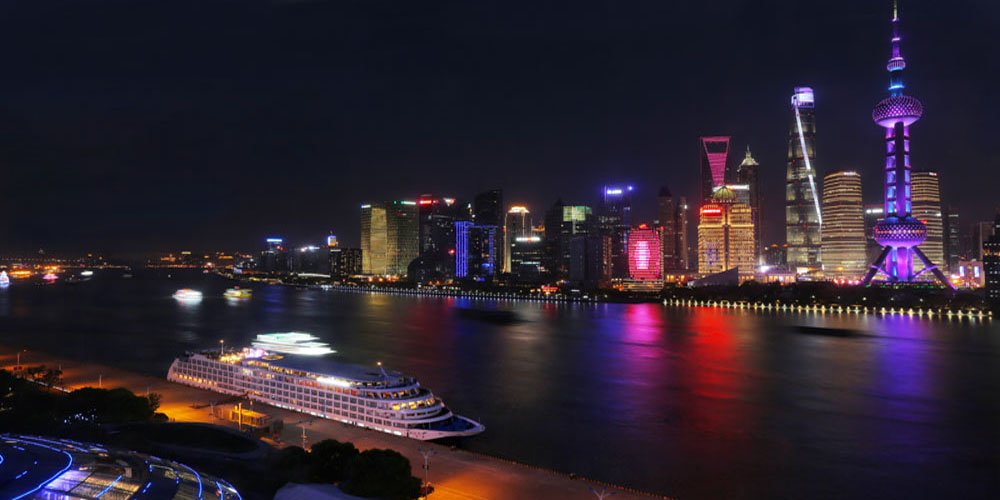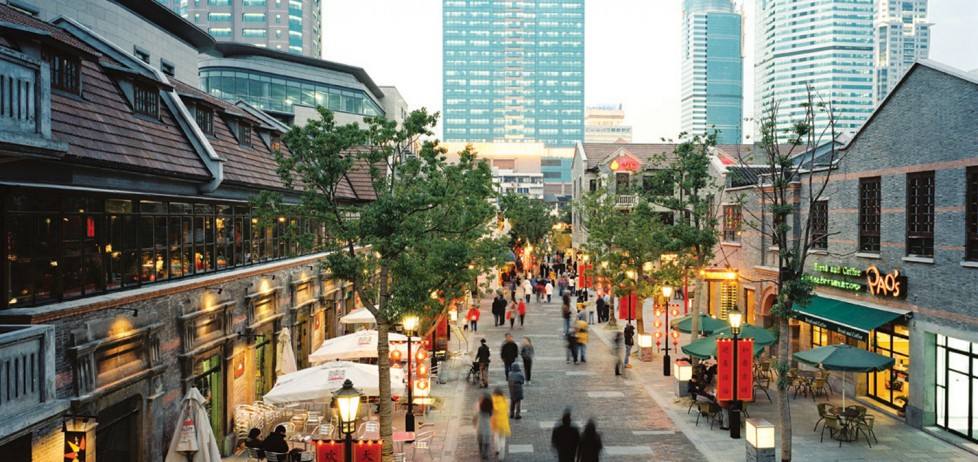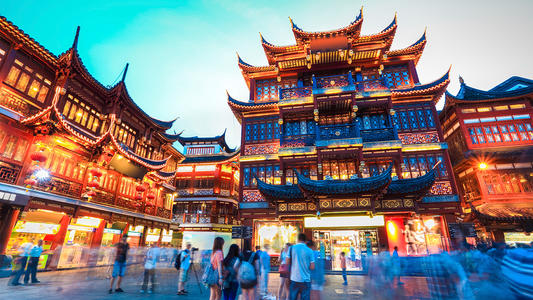Welcome to Shanghai

Shanghai literally means the city by the sea. Shanghai is situated at 31〫14' north latitude and 121〫̊29'east longitude, on the west shore of the Pacific Ocean. It is bordered on the north and west by Jiangsu Province , on the south by Zhejiang Province, and on the east by the East China Sea . Right in the middle of China's east coastline, Shanghai is an excellent sea and river port, boasting easy access to the vast hinterland.
The city is divided into two parts by the Huangpu River: Puxi (west of the Huangpu River) and Pudong (east of the Huangpu River). Puxi is the older part of the city and hosts the majority of shops, restaurants and museums. Pudong is the modern part, and is recognized for its rather unusual yet extremely impressive high-rises such as Shanghai's tallest buildings, the Shanghai International Financial Center, Jinmao Building and the Oriental Pearl TV Tower.
Entering Shanghai, you will immediately be overwhelmed by the hustle and bustle of a thriving city: its colours, its people, its futuristic skyscrapers and indigenous Shikumen houses. Check out this section before coming to Shanghai.
Shanghai Huangpu River Night Cruise

The Huangpu River is the mother river of Shanghai. Nanpu Bridge, Yangpu Bridge and Oriental Pearl TV Tower compose of a huge picture scroll. The Bund is the cultural section of Shanghai that best represents the blending of ancient and modern influences. This renowned waterfront district is the city's most famous landmark. Local people honor the Huangpu River as Mother River, and as you view the lights and spectacle from the deck of your evening cruise, you will understand why.
Between the stately colonial edifices along the Bund, the glittering skyscrapers on the eastern shore of Pudong, and the unceasing river traffic, there is plenty to keep your eyes from ever resting. Besides offering a privileged view of the bridges that span the Huangpu, the cruise boats also offer an excellent view of the famous colonial-era buildings that make up the Bund, buildings such as the Peace Hotel with its unique pyramid roof in blazing green and the Customs House with its large clock tower.
The main ticket office of Huangpu River Cruise is opened daily, and the schedule usually includes a full morning cruise (from 9am to 12:30pm) and a full afternoon cruise (from 2 to 5:30pm). Both these full cruises make a complete circuit of the Huangpu to its mouth. The Huangpu River cruise company also offers a night cruise from 7 to 9pm, splendid when the lights are on the Bund and Pudong, but this voyage does not go downriver to the Yangtze. Cruise schedules vary depending on the season, and on weekends additional cruises are sometimes added.
Xintiandi
Add: South Huangpi Lu Xintiandi, near Madang Lu
Public transport: The closest metro station to Xintiandi is South Huangpi Rd.,
on Metro Line No.1, walking down South Huangpi Rd. or Madang Rd. for about 5
minutes.
Website: www.xintiandi.com

Xintiandi is a car-free shopping, eating and entertainment area of Shanghai. It is composed of an area of restored traditional shikumen ("stone gate") houses on narrow alleys, a modern shopping mall with a cinema complex, and some adjoining houses which now serve as book stores, cafes and restaurants. Most of the cafes and restaurants feature both indoor and outdoor seatings. Xintiandi has an active nightlife on weekdays as well as weekends, though romantic settings are more common than loud music and dance places. Xintiandi means "New Heaven and Earth", and is considered one of the first lifestyle centers in China.
Xintiandi is near the site of the First Congress of the Communist Party of China.
The area was developed by the Shui On Group during the re-development of the surrounding area, when similar shikumen houses were demolished wholesale. The houses in Xintiandi were then restored, and now house an art gallery, cafes, and restaurants. The marketing of xintiandi is mainly targeted towards overseas visitors, especially visitors from Hong Kong, who seek to experience the romanticised atmosphere of old Shanghai. As a result, prices in this area are high, even by international standards. Eating or shopping in this area is seen as a status symbol by affluent local residents. Many tour groups both domestic and from abRd. also visit Xintiandi as one of the main attractions in Shanghai.
Yuyuan
Garden - Shanghai Landmarks Puxi
Add: 218 Anren Rd.
Tel: +86 21 63282465
Opening: 8:30-17:00
Website: www.yugarden.com.cn

A famous classical garden in south China , it was once famed as the "top beauty in southeast China". First built during the Ming Dynasty, 400 years ago, by a Sichuan minister of finance named Pan Yunduan, it has been several times renovated by the government since the Liberation and is now one of the key relic sites in the country under state protection. The garden is divided into the scenic sections of "Mountains and Forests in the City", "Magnificent Woods and Beautiful Valleys", "Historical Relics of Heralding Spring", "Water and Rockery Scenery", "Tops in the World" and the Inner Garden.
People's Square - Shanghai Landmarks Puxi
Public transport: People's Square can be reached by taking
Shanghai Metro Line 1, Line 2 or Line 8 to People's Square station.

People's Square is a large public square just off of Nanjing Rd. in the Huangpu District of Shanghai. People's Square is the site of Shanghai's municipal government building, and is used as the standard reference point for measurement of distance in the Shanghai municipality.
Prior to 1949, People's Square was a part of the horseracing course of Shanghai. After gambling and horseracing were banned, a part of the race course became the People's Square.
In the 1990s, major changes were made to the square. The Shanghai Municipal Government was moved from the former HSBC Building, and the Shanghai Museum was also moved away from its previous site in a former office building. More recent additions include the Shanghai Grand Theatre and the Shanghai Urban Planning Exhibition Hall.
Other parts of the race course still remain today. The clubhouse buildings became the Shanghai Art Museum, while part of the race track became People's Park, a public park.
Prominent landmarks on and around the square include JW Marriott, Shanghai, Shanghai City Hall, Shanghai Grand Theatre, Shanghai Museum, Shanghai Art Museum, Shanghai Urban Planning Exhibition Center and People's Park.
Major department stores on and
around the square include Raffles' City, Shanghai No.1 Department Store and
Shanghai New World Department Store.
The Oriental Pearl TV Tower - Shanghai Pudong Landmarks
Add: 1 Pudong Century Avenue, Shanghai
Tel: +86 21 58791888
Public transport: The closest metro station to the tower is Lujiazui Station on
Metro Line No.2.
Website: www.opg.cn

The Oriental Pearl TV Tower is located at the tip of Lujiazui in the Pudong district, by the side of Huangpu River, opposite The Bund of Shanghai.
It was designed by Jia Huan Cheng of the Shanghai Modern Architectural Design Co. Ltd. Construction began in 1991 and the tower was completed in 1995. At 468 m (1,535 feet) high, it was the tallest structure in mainland China from 1994 to 2007, when it was surpassed by the Shanghai World Financial Center. The Oriental Pearl TV Tower belongs to the World Federation of Great Towers.
The tower features 11 spheres, big and small. The two biggest spheres, along the length of the tower, have diameters of 50 m ( 164 ft ) for the lower and 45 m ( 148 ft ) for the upper. They are linked by three columns, each 9m ( 30 ft ) in diameter. The highest sphere is 14 m ( 46 ft ) in diameter.
The entire building is supported by three enormous columns that start underground.
The tower has fifteen observatory levels. The highest (known as the Space Module) is at 350 m ( 1148 ft ). The lower levels are at 263 m ( 863 ft ) (Sightseeing Floor) and at 90 m ( 295 ft ) ( Space City ). There is a revolving restaurant at the 267 m ( 876 ft ) level. The project also contains exhibition facilities, restaurants and a shopping mall. There is also a 20 room hotel called the Space Hotel between the two large spheres.
An antenna bRd.casting TV and radio programs extends the construction by another 118 m ( 387 ft ).
The design of the building is based on a verse of the Tang Dynasty poem Pipa Song by Bai Juyi about the wonderful sprinkling sound of a pipa instrument, like pearls, big and small falling on a jade plate.
Seen from afar, the Yangpu Bridge and the Nanpu bridge seem like two Chinese dragons frolicking with the pearls of the Oriental Pearl tower.
The Pearl Tower attracts over three million visitors each year.
Shanghai Metro & LRT Route Map

